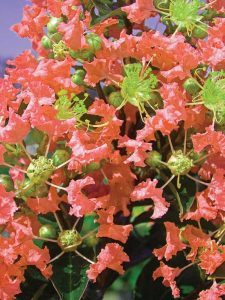Learn about crepe myrtle care and crape myrtle varieties for an outstanding ornamental tree in any landscape.
Americans savor an abiding love affair with trees. Favorites produce showy flowers that herald each spring with massive displays on leafless branches — think dogwood, red bud, flowering cherry, and fruit trees. But while a spring gallery of rooted bouquets is undeniably sublime, it is short-lived. It seems as though in Mother Nature’s fervor to replenish her bounty, flower petals quickly fade and fall, only to be replaced with a ubiquitous wash of greenery.
Not so with crepe myrtle trees (also spelled crape). Technically, the crepe myrtle is a small, upright deciduous tree that hails from the warm regions of each variety’s respective geographical homes — for example, Lagerstroemia indica is native to Southeast Asia, and L. fauriei is native to Japan. Although they do not carry the same storybook aura as, say, the Japanese flowering cherries, Lagerstroemia still puts on a stunning show year-round.
Soaking up the sun
When they blossom, crepe myrtles are not a breakout, flash-in-the-pan showstopper. Rather, they retain their beauty throughout the blooming season and remain exuberant throughout most of the summer. It is this time of year when the crepe myrtle bears witness to the warm weather, long days, and vacation time that combine to allow for our unfettered enjoyment of outdoor fun. The peak blooming period for crepe myrtles often coincides with Independence Day.
Flowers begin blooming with rapid succession in numbers upwards of 300 flowers into dense pyramid-shaped clusters called panicles — a kind of inflorescence. Much like fluffy cotton candy on a cone, these panicles perch at the end of every new sprig.

The overall appearance is that of an intricate pinwheel about 1-1/2 inches in diameter. This is a result of a whorl of small, outer sepals, stalked petals, two sets of stamens (male), and a central female pistil. Surprisingly, the flowers have no noticeable fragrance, although a few cultivars do waft a mild lemony scent. Be that as it may, the flowers remain irresistible to honeybees — their chief pollinators.
In the height of summer growth, the trees’ paper-thin bark peels off in long strips to reveal a fresh, velvet-smooth, neutral-toned skin tinged with pink, cinnamon and mahogany. The combination of floral and trunk decadency is a display that brightens any landscape.
A seasonal wardrobe
Come winter, the trees take on a whole new distinguishing guise. Now leafless, the trunks’ architecture assumes the limelight while the dried seed pods cling to bare branches. Crepe myrtles are characteristically multi-trunked with larger varieties in the South reaching maximum heights of 15 to 35 feet with a canopy span as large as 25 feet. Trunks are usually quite sturdy — sometimes entirely erect, other times gracefully curved, but always smooth with some degree of fluting. And because of the prior summer’s exfoliated bark, the trunks and bifurcated branches are now major visual candy.

While summer and winter are indeed the primary expos for crepe myrtles, spring and fall are not without their own allures. In spring, for instance, the nascent leaves of many varieties are a glossy copper-red. When viewed from a short distance away, the combination of the delicate leaves and the open-scaffolding appearance of the branches create the impression of intricate lacework.
Over time, the foliage matures and envelops the branches with vegetative green. With fall’s arrival, the green chlorophyll begins to degrade, leaving behind a new jaw-dropping palette of colors, its vibrancy competing with the blush of autumnal sunsets. Throughout the South, where cool-season color change is minimal in native trees, crepe myrtles take center stage.

How Much Can You Prune a Crape Myrtle?
With such superlative qualities, it seems unthinkable that the crepe myrtle would fall victim to the mistake of over trimming. Over the last decade or so, a growing number of homeowners and lawn maintenance personnel have taken to trimming larger trees with axes and chainsaws. Called lopping, cropping, docking, hacking, or buzz cutting, the effect is always the same: gross mutilation and violation of a beautifully intricate tree.
Crepe myrtles are tough-as-nails, so they usually do not die, but disfigurement is permanent. Over trimming causes growing twigs to radiate in all directions, giving the impression of a porcupine or pincushion, resembling nothing of the stately appearance of the original.
Adding insult to injury, the massive wounds invite an invasion of pathogenic fungi, which in turn fosters an equally unsightly growth of tumorlike cankers and knots. In order to call attention to this damaging, unwarranted — and I dare say, merciless — practice, professionals have coined the term “crepe murder.” Even so, each year the trend spreads, depriving the public of a tree that could grace all seasons and landscapes with its matchless beauty.
Crape Myrtle Varieties
A number of varieties are available to suit almost any landscape. Some of the varietal differences include growth form (height and canopy girth), flower color, blooming period and leaf color. In my part of the country — southern Louisiana — the variety labeled Natchez White is our Southern belle. This cultivar is tall, with multiple trunks that are mottled with deep mahogany, and the flowers, of course, are white.

The crepe myrtle has become one of America’s most beloved and cherished decorative trees. Their ease-of-care, wide array of varieties, and ability to fill a yard with brilliant displays of color makes them an easy choice for an ornamental tree. The result is a living sculpture that brings to life what would be an otherwise drab landscape.
10 Tips for Crepe Myrtle Care
Crepe myrtles are resilient trees that require little nurturing if planted in hot-summer regions — USDA Plant Hardiness Zones 7 through 9, including the South, most of the East Coast, and much of the West Coast. Planted as individuals or in groupings, the ornamentals make spectacular accents and provide limited shade. Additionally, since crepe myrtles maintain relatively low, compact growth and are highly drought resistant, they are ideal choices for commercial and public urban venues where irrigation is difficult (housing development/estate entranceways, shopping malls, parking lot islands, and street/highway medians).
- Select a variety that is appropriate for your landscape. Choose short cultivars for smaller spaces and tall ones where there is room to expand. Local nurseries can advise for your region and specific installation.
- Being drought-resistant, crepe myrtles generally do not require an irrigation system. However, if spring is exceptionally dry, provide supplemental water to guarantee maximum formation of flowers.
- While crepe myrtles don’t require fertilizing, an annual application of a slow-release shrub/tree fertilizer will encourage prolific blooms and a healthy root and stem system. Apply when leaf buds begin to swell. (In the Deep South, this is mid-March.)
- Most soil types will do fine, although neutral to slightly acidic, loamy, and moderately dry soils work best.
- If lichens — flat, circular, grayish patches with a leafy texture — become established on trunks, fertilize immediately. Bark and lichens will then slough off during the next few months, leaving behind fresh lichen-free bark.
- Suckers — new root growth — will sprout from the base or roots of your tree. If left intact, the tree’s symmetry will be compromised. To maintain symmetry, snip off each sprout at its base.
- Don’t engage in “crepe murder.” No lopping and no wholesale cutting of trunks/limbs larger than 1 inch in diameter. If alteration is absolutely necessary, practice selective pruning — remove one element at a time, keeping in mind the tree’s integrity and health. With your creativity, virtually any tree can be trained to accommodate a difficult setting. If you feel inexperienced, hire a licensed landscaper who has proven pruning skills, or enlist an expert’s help.
- Aphids can be problematic for foliage. These pests produce sticky secretions called “honeydew” that drip from the leaves, appearing as though your crepe myrtle is “crying.” These secretions stimulate the growth of sooty mold, an unsightly black coating on leaves. To remedy this, spray with a soap-water solution or a commercial insecticide. Recently, in Texas and Louisiana, a new invasive insect has been reported. Called the “crepe myrtle bark scale,” these small, flat insects attach themselves to the bark of the tree. Like their aphid cousins, they secrete honeydew, again causing sooty mold. The most effective treatment involves drenching the soil surrounding the trees with a systemic insecticide.
- Select a sunny or partially shaded location. Do not plant in heavy shade. Sunlight promotes maximum blooming, foliage and symmetrical growth.
- Keep lawn mowers and weed trimmers away from the base of your tree. As with crepe murder, physical damage to the base of a tree promotes the invasion of fungi and the growth of cancer-like nodules.
Popular Varieties for Zones 7, 8 and 9
(Most varieties are crosses between Lagerstroemia indica and L. fauriei for long blooming periods and high disease resistance.)

- Muskogee — Light lavender flowers, decorative mottled cinnamon trunks, 20-30 feet
- Natchez White — White flowers, decorative mottled mahogany trunks, 20-30 feet
- Miami — Dark pink flowers, decorative mottled brown trunks, 20-25 feet
- Acoma — White flowers, decorative mottled tan trunks, 20 feet
- Catawba – Purple flowers, decorative mottled brown trunks, reddish spring foliage, 15-20 feet
- Tuscarora — Rosy pink flowers, decorative mottled cinnamon trunks, 15-20 feet
- Sioux — Bright pink flowers. Dark green foliage, outstanding fall color, 12-15 feet
- Tonto — Red to fuchsla flowers, decorative mottled cream/gray trunks, reddish spring foliage, 10-12 feet
- Near East — Pale pink flowers, open/spreading form, slow-growing, 6-18 feet
- Early Bird — Lavender, purple, white flowers, early blooms, reddish spring foliage, 5-8 feet
- Dixie Series — (Baton Rouge, Cordon Bleu, Delta Blush, Lafayette, New Orleans, Mardi Gras) — variety of colors, miniature/weeping growth form, 1-3 feet
Several new series of crepe myrtles are now available on the market, including Black Diamond, Delta Jazz and Magic. All are low- to medium-height and come in a variety of colors. Their biggest allure is their summer leaf color, which is dark green to purple to near black.
Gary Noel Ross, PhD., is an accomplished entomologist living in Baton Rouge, Louisiana. A retired professor and award-winning nature writer, he enjoys directing butterfly festivals for the North American Butterfly Association and capturing impressive nature images.







